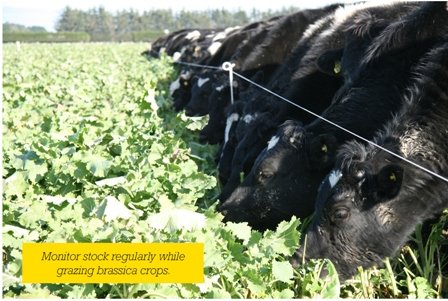Can You Feed Beef Cattle on Kale
Brassica grazing management
Brassicas require careful grazing management, particularly while they are being introduced to stock, Most animal health issues happen in the first few days of feeding.
Introducing animals
Animals coming from other feeds need time to adapt to a brassica diet, so introduce them slowly from an initial 1-2 hours a day up to their maximum daily allowance over 7-10 days. This helps prevent problems like scouring, acidosis and nitrate poisoning due to a sudden change in diet. During the introductory period, animals should be initially put on to the crop when reasonably full, to slow the rate of intake, until they have adjusted to the diet.
The brassica portion of the diet should not exceed 70-80% of total intake, while lactating dairy cows should not exceed 30%. Where brassicas make up the majority of daily intake, a source of fibre (e.g. hay, straw, silage) should be offered to slow the rate of brassica intake, and help maintain rumen function. It is best to feed this fibre source before allowing stock access to the brassica.
Stock may also need additional trace elements such as copper, selenium, iodine and magnesium. Check with your local vet for details.
Always offer plenty of clean water to ensure DM intakes do not drop.
Crop utilisation
Utilisation of brassicas is highly variable, depending on the soil type, climatic conditions, brassica type and desired animal performance. There is generally a trade off between utilisation and animal performance. Where high weight gains are required, lower utilisation must be accepted.
A survey on utilisation of kale by cows found average crop utilisation to be 80%, however, it ranged from less than 40% to more than 90%. As a rule of thumb typical utilisation of kale by cows in dry conditions is 80% and if increased liveweight gains are required utilisation of 75% or less should be accepted.
Break feeding is the best method of feeding brassicas, as it allows a higher level of control over animal intake, utilisation, crop regrowth potential and how long the crop will last for. Offering long faces of the crop, with small, frequent shifts so that actual break size is minimised, results in less trampling and wastage, and higher crop utilisation.
Where a crop has regrowth potential, such as a rape or leafy turnip, back fencing is recommended to maximise yield potential.
Crop allocation
It is important to set targets for stock performance so the correct feeding level can be calculated for brassica crops. Examples are a gain of 0.5 body condition score (BCS) in cows over 6 weeks; or ewe lamb growth of 250 g/day. It's also important to monitor stock on the crop.
For example, to maintain cow condition on kale you need to feed approximately 10 kg DM/cow/day, typically 8 kg crop plus 2 kg straw/hay or silage. To gain 0.5 BCS you need to feed around 14 kg/cow/day, comprising 12 kg kale plus 2 kg straw/hay or silage.
To check allocations are correct, grazing needs to be monitored, because stock are the final judge as to whether estimates of DM yield, break size and crop utilisation are correct. For example in the case of kale, to effectively gain 0.5 BCS approximately 25% of the stem should be left behind on the paddock. Making the cows work to eat the remaining stem means the allowance is too low, and they will not gain condition.
Accurate yield estimates, break measurements, and crop residuals are essential for allocating the desired animal allowances.
Transition around calving
Feeding pregnant stock brassicas too close to giving birth can lead to metabolic problems. Ideally, animals should be transitioned back to a grass based diet two weeks before calving.
Monitor stock
Stock should be regularly monitored while grazing brassica crops to check if they are meeting condition/liveweight targets. For dairy cows, the target for calving is a body condition score (BSC) of 5 for mixed age cows, and 5.5 BCS for first and second calvers.
If animal performance targets are not being meet, DM allowance may need to increase. Feeding levels should be monitored to make sure animals are receiving enough. (Check the amount of feed still available in the afternoon, after morning break shifts).
Some animals, no matter how much brassica DM they are offered, simply do not do well on these crops. These animals should be removed and put back onto pasture.

Source: https://www.barenbrug.co.nz/dairy/brassica-management/yield-and-grazing-management/brassica-grazing-management.htm
0 Response to "Can You Feed Beef Cattle on Kale"
Post a Comment